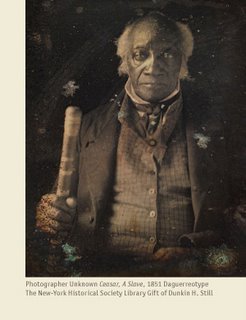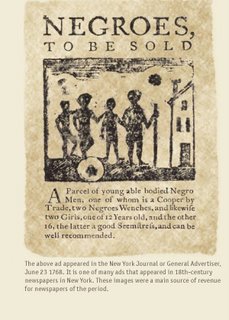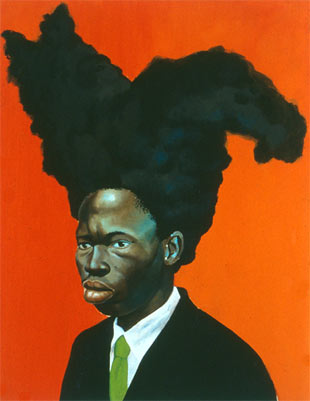

When our school textbooks pontificate on slavery in America, various southern American cities bear the brunt of our anger about perhaps the most horrific event in our history. So when those signs went up around the city about “Slavery in New York”, I had to double-take and think back to elementary school- being 10 years old watching “Roots” on television. Didn’t all of that happen in Georgia and other southern states? Isn’t that what a large part of the Civil War was about- the Northern state’s insistence that the southern states rid themselves of the “original” apartheid? The Northern states get off easy in this example. However, traditional history deletes the North’s establishment and CONTINUATION of this institution, and that story needs to be told. Thanks to the New York Historical Society’s $5 million exhibit (and a friend of mine, Teresa, who works there and gave me a PERSONAL tour), ALL of that has been called into question and onto the carpet, de-mystified, and put out there for everyone’s information/consideration. Alex Haley had ONE story, which focused on the psychological ramifications of slavery; and here is but one of MANY stories on the subject that we haven’t heard before: the economic benefits that slavery afforded rich Northern whites, and how slaves literally built one of the greatest cities in America. For those of us who missed the story about the “discovery” of an 18th-Century African burial ground in New York in 1991, this exhibit gives us context. For those that were intrigued by it, “Slavery in New York” furthers what any black person in America knows already- this country could NOT have become what it has without us; the foundation for this country was built on OUR backs.
The exhibit (www.SlaveryinNewYork.org) in and of itself is quite comprehensive and well-presented. The scope and depth of the northern slave trade is presented painstakingly in original documents, televised and live discussions, creative multimedia presentations, and the like. It starts with the Dutch dropping off Jan Rodrigues (an African) on American soil and continues through the darkest period of American history onto the establishment of African-American institutions post-Civil War. In between, you get a rich history of how for almost 300 years, slavery- and whites’ perceived necessity of its preservation- established itself as THE most important product in New Amsterdam, and how that mindset (and laws enacted to further that mindset) built one of the most formidable ports in the north- which we now call New York.
And now…the RE-EDIT:
I think this information is important for too many reasons to discuss- if only to open the dialogue about historical inaccuracies, political correctness and a “setting-straight” of the facts, be they known or unknown. In this vein, one of a couple of things that struck me was that there was a movement AFTER the emancipation of blacks to “keep us in our place”, even though we were free. The part of the exhibit that dealt with how “free” blacks were treated after the Civil War was the most interesting to me. After we were raped of our skills and talents and used until we served no other purpose, after our backs and bodies were irreparably damaged through unspeakably vile labor (interred remains at the African Burial Ground found broken neck bones, trauma to spines and other signs of repeated stress), we were STILL not allowed to profit. Once blacks were freed, the need for “higher-paying” skilled jobs was available. To my amazement, it wasn’t blacks- who had performed all of those duties in slavery- that were given the opportunity to profit. For the most part, it was the new immigrant Irish (who’d begun landing here- can you say “Gangs of New York”?) that were given access to those economically-empowering jobs. Also interesting was how blacks tried- to varying degrees of failure- to assimilate into society post-emancipation. Although both blacks and Irish were seen as “second-class citizens” (and lampooned in cartoons and other communications) blacks still persevered, establishing their own churches, institutions, and aristocracy. “Slavery in New York” examines the establishment of the first black bourgeoisie (Pierre Toussaint, for example- who was a married hairdresser with an adopted daughter, by the way- hmmm), while skating over the very REAL fact that this city’s current bourgeoisie- the “old New York families”- had the vast majority of their fortunes made as a result of the slave trade, either directly or indirectly (do the names Tiffany, Astor, Livingston, Stuyvesant- to name a FEW- sound familiar?). Those living in the wealthy enclaves we now call Greenwich Village and SOHO sleep on the ground that formerly had slave footprints (and residences). It could be argued that “The City that Never Sleeps” is kept awake by the screaming souls of black folk. These heroes robbed of their skills, their culture, their LIVES, who found themselves placed here courtesy of The Dutch Trading Company for centuries of inhuman conditions and expectations; and whose 20,000 skeletal remains have only recently been properly interred and memorialized (www.africanburialground.com) are still awake- and I suspect not going to sleep any time soon. But I digress-for now anyway…

No comments:
Post a Comment